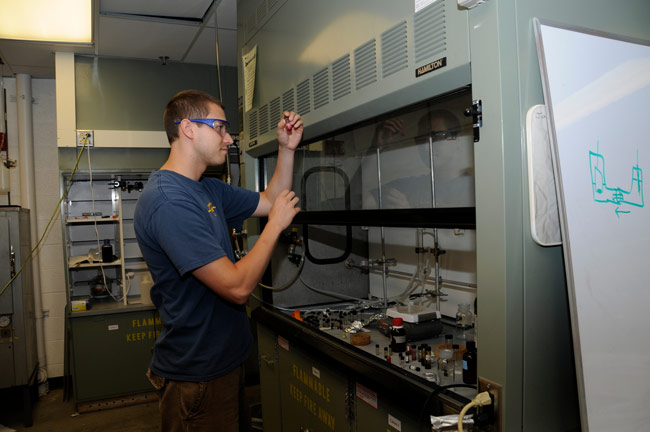Nature Offers Template for Solar Energy Materials

This ScienceLives article was provided to LiveScience in partnership with the National Science Foundation.
Humans require an ever-growing amount of energy to sustain the comfortable lifestyle afforded by our technology. However, we are depleting our fossil-fuel energy resources at an incredible rate and must exploit sustainable, renewable, and preferably domestic sources over the long-term. The sun is one source that can theoretically meet all of our energy needs. In the chemistry laboratories of professors Devens Gust, Ana Moore and Thomas Moore at Arizona State University, graduate student Brad Brennan researches materials meant to harness the energy of the sun and to convert that energy into usable electricity in solar cells or into useful chemicals. The ultimate inspiration for the research is photosynthesis in plants, where a complex harmony of biological pathways uses the energy from sunlight for plant growth. By designing materials to act in a similar, albeit simpler way, they can mimic important aspects of photosynthesis involving light capture and energy conversion. Brennan’s research at Arizona State University has led to the development of a new method to bind light-absorbing compounds to surfaces for use in organic solar cells, and he also has developed a new class of light-absorbing plastics based on a porphyrin pigment. Brennan’s research was also featured in the “Solar” video of the NSF Green Revolution series. Below, Brennan answers the ScienceLives 10 Questions.
Name: Brad Brennan Age: 27 Institution: Arizona State University Field of Study: Chemistry
What inspired you to choose this field of study? From the time I was a small child, I was fascinated with the natural world around me. Meteorology was my first love, but in college I focused on biology and chemistry. During college I became interested in energy and how a cheap, renewable, sustainable energy supply could help solve world problems. That pursuit led me to where I am today.
What is the best piece of advice you ever received? If you want someone to help you, help them first. It stems from ‘reciprocal altruism,’ where helping people when they need it would provide a greater chance that they would reciprocate the help when you need it. I’ve found it works most of the time.
What was your first scientific experiment as a child? When I was very young, I decided to mix an assortment of food colorings with water hoping that something interesting would happen. Of course nothing out of the ordinary occurred except for a large mess. However, it might have been the beginning of my love for cooking.
What is your favorite thing about being a researcher? Being on the forefront of human technological development allows researchers to take a glimpse into the future. It can be reassuring to know that although society has many challenges, there are people working diligently to solve them and provide a better future for all of us.
Get the world’s most fascinating discoveries delivered straight to your inbox.
What is the most important characteristic a researcher must demonstrate in order to be an effective researcher? Problem solving. Research projects are littered with problems requiring creative thinking and perseverance. Sometimes the results show that an experiment will never work and the whole project must be re-designed around the problem or the project is scrapped altogether.
What are the societal benefits of your research? My research on materials for solar energy devices stems from a societal need for a sustainable and environmentally-friendly energy source. The sun has always been the major energy source on Earth, and society would only need to harness a minuscule percentage to satisfy our energy needs.
Who has had the most influence on your thinking as a researcher? I have had many mentors through the years. Each had a different philosophy about science and life that they taught me. They helped me become a well-rounded and open-minded scientist.
What about your field or being a researcher do you think would surprise people the most? It surprises me how often great research discoveries are made by accident. Incredible unexpected results can occur due to simple mistakes, random events or even what should be a straight-forward experiment in the laboratory.
If you could only rescue one thing from your burning office or lab, what would it be? My computer. It is not only full of the data I need to graduate, but it contains new project ideas that have accumulated along the way.
What music do you play most often in your lab or car? In my car I mostly listen to NPR (National Public Radio) and older rock. Led Zeppelin, Rage Against the Machine, Bush and The Smashing Pumpkins are a few of my favorites.
Editor's Note:This research was supported by the National Science Foundation (NSF), the federal agency charged with funding basic research and education across all fields of science and engineering. Any opinions, findings, and conclusions or recommendations expressed in this material are those of the author and do not necessarily reflect the views of the National Science Foundation. See the ScienceLives archive.


